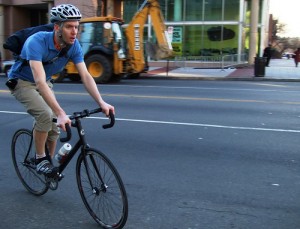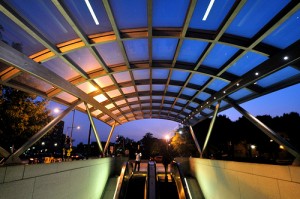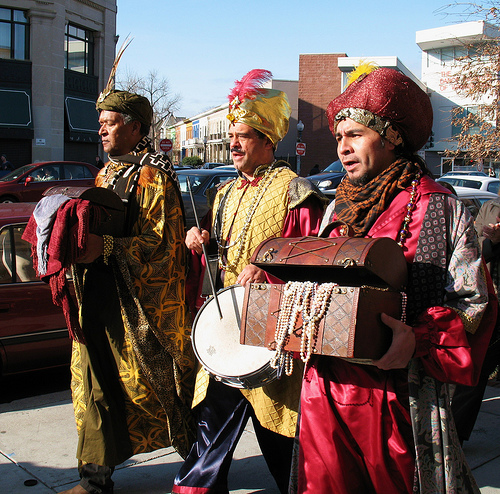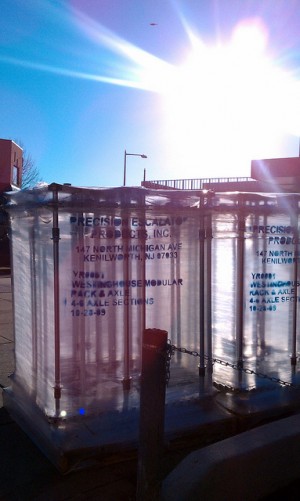January 5, 2011 | 5:45 PM | By Anna

DCentric
Local hot sauce-goodness from Uncle Brotha.
Now reading: “How to be Black“, from Thought Catalog (thanks, PostBourgie):
Really love or really hate Tyler Perry movies.
Get asked every summer if black people tan.
Get laughed at in elementary, junior, and high school by all your black friends because you “talk white.” Philosophize for years about what it means to “talk white.” Have an identity crisis. Go away to college or boarding school and have your new white friends swear up and down you’re nothing like the way black people are “supposed” to be. What happened to you? Go home with your new white friends during holidays, play the role of Model Black.
Seamlessly slip in and out of Ebonics. Talk to your friends in one voice but as soon as a family member or another black calls, thass when you be done’ took the Ebonics out.
Get used to not seeing other black people on the covers of magazines, in any of the advertisements, or in any of the movies. Cringe when Your Local News shows racist images of black people, such as mug shots, jail shots, and videos of robberies. Get used to people assuming you like rap. Get used to things like racism, hot sauce.
January 5, 2011 | 1:43 PM | By Anna

Flickr: Washington Area Bicyclist Association
Bicyclist on 14th Street.
It’s like David Alpert over at Greater Greater Washington is reading my mind– I was just thinking about why a bicyclist racing through a red light at an intersection gets more attention than a car doing it. According to Alpert’s post, “What’s our bicycle “social contract“?”, It might have to do with expectations:
With the frequent calls for cyclists to “start behaving,” it’s clear that a number of people driving and walking are unsettled by the conduct of at least some people on bikes. But people in cars speed all the time, and people walking cross against the light, and neither generates as many newspaper letters to the editor. What is the difference?
One explanation is that people naturally notice infractions by others on different modes more than those on the same mode. People driving tend to see misbehavior by people walking and cycling rather than from other people driving, for example. And since relatively few people ride bicycles while a great many drive, the outraged letters will skew toward misbehavior by those on bikes and away from that from people in cars.
Felix Salmon proposed another interesting explanation a while back. Basically, he argues that we’ve developed a clear understanding of what to expect from people walking and driving generally, but lack that consensus for people bicycling…
Alpert goes on to examine “bike behavior” and offers his opinion on whether each maneuver is good (riding in the middle of a lane) or bad (blowing through an intersection).
January 5, 2011 | 10:40 AM | By Anna

Flickr: Rhys
Shaw, D.C.
Yesterday, I wrote about caustic reactions to the news that more affordable housing is coming to Shaw. One of you left a comment in response to my post that deserves to be seen:
I think we are seeing here is the very real balkanization of urban society that stymies us. I commiserate with both sides, there needs to be affordable housing in the city, and yet it comes fraught with so many problems that makes it unpleasant for the neighbors.
I recently saw a project about The Frederick Douglass Dwellings in Anacostia, that was public housing built in the WWII boom. There were many two parent families and a community center in which the ladies who ran it really took an interest in their charges. They didn’t know they were “poor,” and there was a strong sense of community and family.
There are so many problems here: it’s true that many urban blacks that I have encountered blame their problems on the system, “the plan”, without seeking solutions, but I find this mimicked in modern society too, where many people blame “the media” without questioning their role in propagating a media more concerned with the upcoming royal nuptials than the minutae of the tax code. People do need to start taking responsibility for themselves, their knowledge base, their support of leadership, and their desires to meet and understand their neighbors. Start community watches. Volunteer with big brothers. Don’t accept or make excuses. There will need to be a large attitude adjustment on both sides for anything to change.
January 5, 2011 | 8:26 AM | By Anna
Good morning, DCentric readers! It’s breakfast link time:
No More Washington Wives, and It’s Our Loss “Today, the club, long ago renamed Senate Spouses in a nod to the growing number of women in Congress, meets about once a month, and fewer than a dozen attend. “A lot of the Senate wives don’t live here,” explains Proxmire, “so it would be harder to have a weekly meeting.”…This phenomenon has ramifications far beyond absent parents and poorly attended First Lady Lunches. It’s another component that portends a new level of Capitol Hill gridlock. Real legislating—the compromises and dealmaking that distinguish politics from posturing—happens only among people who know and respect each other.” (newsweek.com)
The poster says: “Keep DC a Chocolate City! Stop DC’s War on the Black Community” “I chose to live in Anacostia for the same reasons that my non–white neighbors have in the past couple of years: affordability, short commute to work, the views of the city, and the friendliness of the people that live here. People say hello to each other here, we greet each other, we still take time to really talk with our neighbors. Maybe I have taken these posters too personally, but in a city that just elected Vincent Gray as Mayor with a mission statement of “One City”, I am dismayed and angered by these blatant words of racism plastered in my neighborhood. I like to think that all of the many varieties of chocolate can be equal, including white.” (anacostianow.com)
D.C. wants to teach juvenile delinquents Yoga, Tai-Chi “Late last month, Holman e-mailed the agency’s staff to see if they have “hidden talents that might be tapped to further our work with the young people in our care.” In the e-mail obtained by The Washington Examiner, Holman said his primary interest was in finding among the staff an instructor certified in yoga, tai-chi, or another “mind-body connection discipline.” The agency is coming off a controversial year during which more than a dozen of its wards were charged with murder and at least a half-dozen were killed. A heavy focus on rehabilitation programs for city youths was blamed by critics for the soaring violence.” (Washington Examiner )
Continue reading →
January 4, 2011 | 11:42 PM | By Anna
I would be a huge fan of this proposal. Blocking intersections is an obnoxious display of selfishness:
De facto commuter tax: station MPD at intersection during rush hour. $200 fine if they "block the box"!!! Grrridlock!
January 4, 2011 | 4:21 PM | By Anna

Flickr: M. V. Jantzen
Shaw Metro station, at 8th & R Streets, NW
So I was reading this post from the City Paper about new, affordable housing coming to Shaw:
It’s a tentative plan, but a plan nonetheless: Lincoln Westmoreland Housing Inc. is moving forward with a 50-unit apartment complex on 7th and R Street NW, right next to the 10-story behemoth constructed right after the 1968 riots.
The new building, designed by Shalom Baranes architects, could not be more ideally located: It sits directly above the Shaw metro station (part of the land will be purchased from WMATA), and across the street from the new Shaw library. It will replace a decked-over parking lot, have retail on the ground floor, and still leave some green space for a sculpture installation.
“Affordable” is the key word here, because as Lydia DePillis reported, the units would be accessible “for people making 60 percent of the area median income”. Sounds great, right? I love neighborhoods that have a range of people from all backgrounds–it’s my favorite thing about Columbia Heights, where there is everything from affordable housing to $3,000 converted condos. The readers who commented on her piece had a different, more bitter take:
Building looks nice and hopefully they will balance income levels. 60% AMI residents will be a welcome addition to the neighborhood and attract civil servants, firefighters, police, teachers etc. But if they decide to concentrate the extremely low income/AMI residents in this building, well they might as well hand over the building to the local thugs so they can have a nice shiny new HQ from which to terrorize the rest of the neighborhood from. [wcp]
Continue reading →
January 4, 2011 | 3:01 PM | By Anna

Flickr: Mr. T in DC
Three Kings in the Epiphany Procession in Columbia Heights, 2009.
The New Columbia Heights blog points out what I missed on Sunday (drat!):
This past Sunday was Epiphany, also celebrated as Three Kings’ Day. Latin American Catholics in the neighborhood (and around the world) celebrate it with a big procession of people dressed as the Three Wise Men, Jesus, Joseph, and Mary, and more, complete with donkeys and sheep.
The procession goes down 14th and ended with a performance at the Gala Theatre, plus free churros and hot chocolate…The reader says more animals showed up a bit later.
Always like to see interesting cultural traditions like this.
January 4, 2011 | 1:42 PM | By Anna

DCentric
These "Precision Escalator Products" were sitting next to the elevator at the Tenleytown/AU station, yesterday.
Finally– some good news, especially for those with mobility issues, who are extra-inconvenienced when a Metro escalator is broken (via WAMU):
Metro is focusing extra attention on its problematic escalators, a frequent source of complaint from riders. The transit agency is starting the new year with a newly appointed general superintendent for elevator and escalator programs.
Veteran engineer Rodrigo Bitar has been assigned to the position. His task: to oversee the repairs and upkeep of hundreds of escalators and elevators that Metro has failed to maintain.
In October, six passengers at the L’Enfant Plaza station were injured when the brakes on a Metro escalator malfunctioned. After the incident, a system wide inspection found additional problems with various Metro escalators.
Bitar will be charged with shepherding repair work laid out in an agency assessment made public earlier this year.
Rodrigo Bitar has previous experience with Metro; in the past, he was the “Director of Quality Assurance and Warranty”. If there’s anything that I encounter on a daily basis in this city that needs some QA– it’s Metro. Go Rodrigo!
January 4, 2011 | 10:35 AM | By Anna

Flickr: stevendepolo
Since I avoided the internet for the last few days of 2010, I’m catching up on all my favorite blogs. This post, “‘Good Hair’ on C.P. Time.” from PostBourgie, reminds me that though I intended to, I still haven’t seen the notable Chris Rock documentary about hair:
This seemed to be the reaction that Rock was nudging the audience toward, even as he seemed to assiduously avoid taking an explicit stance. We watch as a principal ingredient in hair relaxer eats through a metal can, before cutting to a little girl of about three or four who has already started getting her hair permed — the opening night audience in Brooklyn gasped loudly and tut-tutted at this — before seeing how the hair used to make expensive weaves sold stateside is literally shorn from the heads of poor people in South Asia as part of a religious ritual…
That last bit about South Asian temple hair is something I end up discussing almost weekly with someone. The offering occurs at Tirumala Venkateswara Temple, in southern India.
Continue reading →
January 4, 2011 | 8:27 AM | By Anna
Good morning, DCentric readers! Ready for some sizzling links?
D.C. cultural scene adopts new trends in food, fashion, arts, entertainment “The anything-is-possible feeling in Washington right now also prompted two neighbors in Arlington to take a gamble on a food cart in 2009. District Taco co-owner Osiris Hoil had been laid off from his construction work for seven months, and Marc Wallace had just sold his software business when the cart launched with Hoil as its only employee. Last month, they opened a restaurant on Lee Highway; between the old cart, now parked in Crystal City, and the restaurant, they’re the proud bosses of a staff of 30. “Recessions breed entrepreneurs,” Wallace explains.” (The Washington Post)
Disturbing: Headless rooster found on Otis Place “It’s the weekend of strange things on the sidewalk — Patron, paint drippings as graffiti, and now a headless rooster. A reader sent this in, spotted on Otis Place between 14th and 16th. Strange stuff. Apparently rooster sacrifice is done in the Santeria religion, which mixes Afro-Caribbean beliefs and Roman Catholicism: something similar happened in New Jersey a few months ago, for example. The roosters are sacrificed for saints or as an offering. Kind of disturbing, and also unsafe, since they probably have germs and could attract rats.” (New Columbia Heights)
Will Mayor Gray also run the city council? “The council could be in danger of becoming a rubber stamp for the mayor,” one veteran D.C. politician says. “Too much power in the hands of one individual — whether it’s Marion Barry or Vince Gray — is always dangerous.” He’s referring to Marion Barry’s first two terms as mayor, when the council members were known as “Marionettes,” more enablers than legislators…As for loyal opposition, we have Muriel Bowser from Ward 4, at-large member David Catania and Jack Evans, whose ward runs from Georgetown through downtown to Shaw. With seniority and spunk, Evans could wind up leading the opposition.” (Washington Examiner )
Continue reading →











